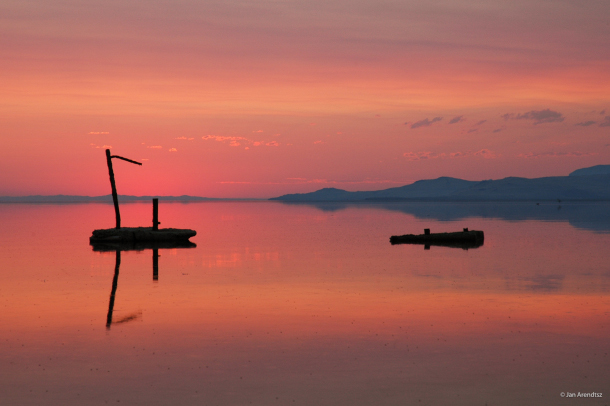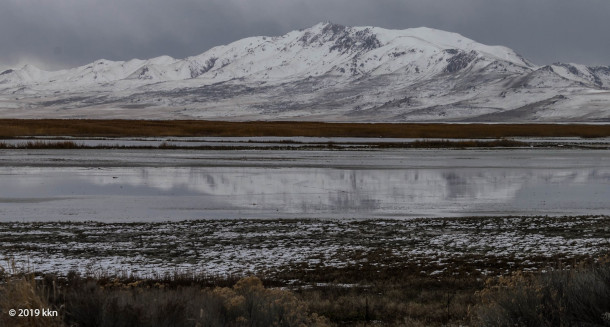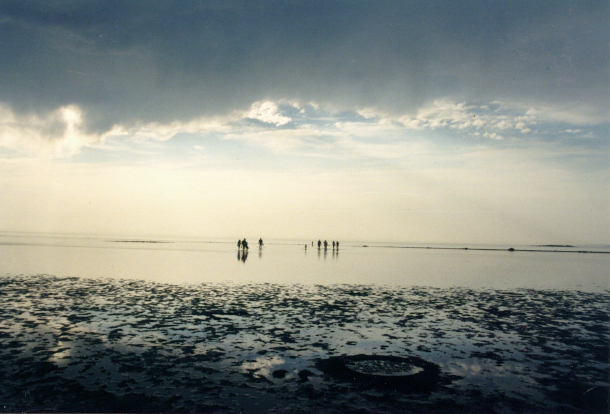Great Salt Lake Going Dry
Air Date: Week of February 10, 2023

A new report found that the Great Salt Lake will disappear in 5 years if water consumption isn't cut almost in half in the next two years. (Photo: Jan Arendtsz. Flickr, CC BY-ND 2.0)
Since 1860 the Great Salt Lake has lost three-quarters of its water, mostly due to human activities, and some scientists now predict it will dry up completely in the next five years unless emergency conservation measures are taken. The loss of the lake would devastate migratory bird populations and create a public health crisis linked to toxic dust in the lakebed. Brigham Young University ecologist Benjamin Abbott spoke with Host Jenni Doering about the crisis and why water conservation in the agricultural sector is vital.
Transcript
CURWOOD: From PRX and the Jennifer and Ted Stanley Studios at the University of Massachusetts Boston, this is Living on Earth, I’m Steve Curwood
DOERING: And I’m Jenni Doering.
When European explorers found the Great Salt Lake in what is now Utah, they encountered the largest inland saltwater body in the Western Hemisphere and the eighth largest in the world. But since 1860 the Great Salt Lake has lost three quarters of its water and some scientists now predict it will dry up completely in the next five years if nothing is done. Part of the problem is the climate disruption that is driving a water crisis across the American west, with Lakes Mead and Powell along the Colorado river also at record lows. But scientists say human overuse is a more important threat to the future of the Great Salt Lake. Benjamin Abbott is an ecologist at Brigham Young University in Provo Utah and co-author of a recent study that calls for emergency action. Professor, welcome to Living on Earth!
ABBOTT: Thank you so much, Jenni.
DOERING: So what is happening to the Great Salt Lake?
ABBOTT: For over 100 years, we've been using too much water in great salt lakes watershed, and the lake level has been gradually declining. But what we've seen over the past few years is the lake level has really taken a nosedive, and we've been losing 1.2 million acre feet of water a year. If we continue to lose water at the rate that we are, then we're looking at a five year timeline before the lake as we know it, doesn't exist anymore.
DOERING: So what would that mean for the people, the animals ecosystem of the Great Salt Lake region? What would a collapse really look like?
ABBOTT: Great Salt Lake is what we call a keystone ecosystem. It holds up and supports so many ecosystem services for society, and also inherent environmental processes. Great Salt Lake is the largest saline lake in North America. And it exists right in the middle of the Great Basin. So it's this giant area covers a big portion of Utah and Nevada, little bit of the state's around that doesn't drain to the ocean at all drains down into the salty lakes. It's about 98% land. So every little fragment of aquatic habitat is really important for local wildlife. Also, for migratory birds, this is part of the Pacific Flyway and 10 million migratory birds, about 350 species of birds depend on Great Salt Lake at different parts of their lifecycle. And that's just one of the dimensions kind of the environmental side, if we lose the lake, we're going to see hemispheric ripples that go through not just the Utah Nevada region, but all throughout North and South America with these bird species that are traveling to those regions. There's a more dire and direct impact that we would see. Because these saline lakes are like bathtubs, they're all draining down to the bottom through time, they accumulate a lot of both natural and human created pollutants, things like heavy metals and Cyanotoxins, herbicides, pesticides. But as these lakes shrink, then that sediment is exposed, and those pollutants can become airborne. And we've already begun to see an increase in these toxic dust storms from Salt Lake and the surrounding drying out Lake basins.

A recent report from nearly three dozen scientists and conservationists found the lake is now 19 feet below its natural average level and has lost 73 percent of its water amid excessive water use and a worsening climate crisis. (Photo: Kari Nousiainen, Flickr, CC BY NC 2.0)
DOERING: What is on the other side of the equation, you know, the economic value of taking the water from the lake?
ABBOTT: The lake directly supports around $2.5 billion a year of economic activity. That's primarily mineral extraction from the lake. Great Salt Lake is the only source of magnesium in the United States, the lake is a very large tourist draw. And so you have people from around the world who are coming to experience this unique ecosystem.
DOERING: So what are the biggest reasons for the great salt lakes disappearance right now?
ABBOTT: There's a pretty clear dominant cause about 80% of the loss of water is being caused by irrigated agriculture. These are freshwater streams and rivers that would naturally flow to the lake. And we're diverting that water using it to grow especially alfalfa, but other crops as well, that's 80% of the problem. Now, between five and 15% of the issue is also climate change, right. These long term warmer and drier conditions that have set up that reduce the natural amount of water, and then the remaining 10% is that industrial extraction of water from the lake and urban water use. So this is really fundamentally different than some other areas, right? You might have heard about the situation in Las Vegas, where really, they're crunched, they don't have water for people to drink. So you have to recycle the water, or South Africa, where Johannesburg literally has to turn off the municipal water supply. It's not a story of people brushing their teeth for too long or taking too many showers. This is all about outdoor water use. From the beginning we've over allocated the water resources. And throughout the 20th century in the western US, we had this obsession with these large water projects. And that created artificially subsidized water that then encouraged growth of types of agriculture that really have no business existing in this region.
Important coverage by @BillWeirCNN on the drying of Great Salt Lake.
— Ben Abbott (@thermokarst) February 10, 2023
As Dr. Bonnie Baxter says, “This is an ecological disaster that will become a human health disaster...We see a crisis that is imminent.”
Let's #growtheflow to #GSL
https://t.co/p0koeFcVNg.
DOERING: So, what are some of those options that could keep this agricultural economy alive without using nearly as much water as they are now?
ABBOTT: One of the best options is actually keep growing the crops that you're growing, just do it more efficiently. And alfalfa is a great example. This is a crop that is a multi-year crop. You can actually keep growing alfalfa keep growing the other crops that you're growing, just do it better. This is called agricultural optimization, transition from flood irrigation, which is the most common type of irrigation in the watershed right now. Transition to sprinklers and then with alfalfa, it's quite flexible where let's just do one or two cuttings instead of three or four, and we could very easily see 50, 60, 70% reduction in the amount of water being used for those crops while still allowing and supporting this agricultural part of the economy and identity here.
DOERING: Why are farmers not already adopting some of those practices like, you know, one, two cuttings instead of three or four that you say could maybe save a lot of water?
ABBOTT: It's very easy to say, I can't believe that these farmers are doing these things. But we need to take a look at what the law is what the incentives are. And literally until just a few months ago, Utah had a use it or lose it water law, this is very typical for states in the West. So if you have a water right to, let's say, 1000 acre feet of water, you don't need all of that water to grow your crops, maybe it was a wetter year, or maybe you don't have all of your fields in cultivation. Well, if you don't use it all, then that water can be taken and allocated to someone else. Thankfully, the legislature changed that law. And it is now is possible to say, okay, I'm only going to use what I need, and then I'm going to designate the rest for they call it environmental flows, you no longer risk losing that water. In fact, you can even be paid for that water right that you're allowing to go to Great Salt Lake. And so, this is not an issue of the ignorant farmers or the uncaring farmers, this was a system that really discouraged conservation. Things that we're calling for in our report is, let's send out water educators, ambassadors, lawyers to every corner of the watershed so that every farmer knows what resources are available for agricultural optimization, and that they have the support, the financial and legal support they need to make those changes.

The lake and its wetlands provide minerals for Utah’s industries, thousands of local jobs, and habitat for 10 million migratory birds. (Photo: Stephanie Young Merzel, Flickr, CC BY 2.0)
DOERING: What are some of the ways that the Utah State government can help remedy this situation that's happening in the Great Salt Lake?
ABBOTT: I think we need two kinds of action. We need legislative change that's going to encourage long term conservation finally bring our demand in line with what the environment here can support. Some of that has already been passed, the 2022 legislative session was called the year of water. However, most of those efforts are going to take multiple years, maybe even a decade or two to bear fruit, you know, before they start returning water to the lake and we simply don't have that much time. We need emergency releases of water from reservoirs in Utah. No one has succeeded in stopping or at least restoring these saline lakes systems when they start to decline. Looking at the Aral Sea, Lake Urmia, Owens Lake, Mono Lake, Lake Chad, right, you can go across all the continents success looks like maybe slowing the rate of decline, or in some edge cases stopping it for a period of time.
DOERING: How optimistic are you that things can turn around for the Great Salt Lake?
ABBOTT: The number one thing that makes me optimistic maybe sounds strange, but we've been wasting a lot of water. If you look at the per capita water use in Utah, it's very high. And if you compare it to other dry regions on the planet, we use almost seven times more water per person than the country of Israel does. And so that actually gives us a lot of room for improvement. With some pretty common-sense changes, we can get the kind of conservation we need. We estimate, looking at the lake’s hydrology over the past few decades that we need to reduce water use by 30 to 50% per capita, we're not talking about minor changes, but our agricultural water use, or outdoor urban water use, has been so inefficient in the past that we can do that easy. We can meet those targets. I really believe we can do it; it still is going to be tight. We don't have much buffer left; the lake is almost dry. And so, we've got to do this fast. But as far as is it even technically possible or feasible, resoundingly yes. There's no question. We could do this if we focus, if we bring the resources to bear that we need.
DOERING: Ben Abbott is an ecology professor at Brigham Young University. Thank you so much, Ben.
ABBOTT: Thank you so much, Jenny for bringing attention to this important issue.
Links
The Guardian | “‘Last Nail in the Coffin’: Utah’s Great Salt Lake on Verge of Collapse”
Living on Earth wants to hear from you!
Living on Earth
62 Calef Highway, Suite 212
Lee, NH 03861
Telephone: 617-287-4121
E-mail: comments@loe.org
Newsletter [Click here]
Donate to Living on Earth!
Living on Earth is an independent media program and relies entirely on contributions from listeners and institutions supporting public service. Please donate now to preserve an independent environmental voice.
NewsletterLiving on Earth offers a weekly delivery of the show's rundown to your mailbox. Sign up for our newsletter today!
 Sailors For The Sea: Be the change you want to sea.
Sailors For The Sea: Be the change you want to sea.
 The Grantham Foundation for the Protection of the Environment: Committed to protecting and improving the health of the global environment.
The Grantham Foundation for the Protection of the Environment: Committed to protecting and improving the health of the global environment.
 Contribute to Living on Earth and receive, as our gift to you, an archival print of one of Mark Seth Lender's extraordinary wildlife photographs. Follow the link to see Mark's current collection of photographs.
Contribute to Living on Earth and receive, as our gift to you, an archival print of one of Mark Seth Lender's extraordinary wildlife photographs. Follow the link to see Mark's current collection of photographs.
 Buy a signed copy of Mark Seth Lender's book Smeagull the Seagull & support Living on Earth
Buy a signed copy of Mark Seth Lender's book Smeagull the Seagull & support Living on Earth

